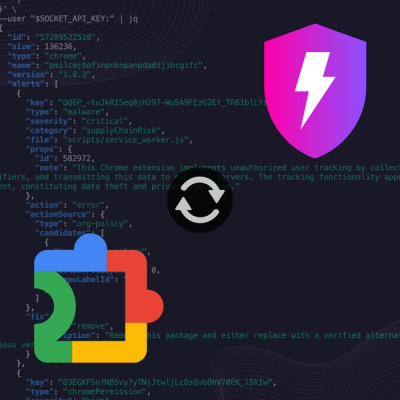
Product
Socket Now Protects the Chrome Extension Ecosystem
Socket is launching experimental protection for Chrome extensions, scanning for malware and risky permissions to prevent silent supply chain attacks.
graphql-codegen-typescript-mongodb-template
Advanced tools
This package generates TypeScript types for MongoDB server-side developers.
It uses GraphQL directives to declare the types you want to generate and use in your MongoDB.
It take a declaration like this:
type User @entity {
id: String @id
username: String! @column
email: @column
}
And generates a TypeScript interface like this:
import { ObjectID } from 'mongodb';
export interface UserDbObject {
_id: ObjectID;
username: string;
email?: string | null;
}
So you can use it when you read/write to your database, and expect a specific structure.
To use this package, install is using Yarn into your project, as a dependency:
yarn add graphql-codegen-typescript-mongodb-template
Then, you need to add the directives declaration to your GraphQL Schema definition:
import { makeExecutableSchema } from 'graphql-tools';
import { DIRECTIVES } from 'graphql-codegen-typescript-mongodb-template';
const schema = makeExecutableSchema({
typeDefs: [
DIRECTIVES
// the rest of your GraphQL types
],
resolvers
});
Now, use this template with the GraphQL code generator:
gql-gen --template graphql-codegen-typescript-mongodb-template --schema ./src/my-schema.js
IMPORTANT: Because of GraphQL behavior, you have to use --schema and provide a JavaScript export, otherwise you will lose your GraphQL Directives usage
Now, add the directives to your GraphQL definitions, and generate your MongoDB models file.
@entity(embedded: Boolean) (on TYPE)Use this directive to declare that a specific GraphQL type should have a generated MongoDB models.
embedded: Boolean - specify this to declare that this entity turns into an object inside another entity. For example, if you want your structure to be { _id: string, username: string, profile: { name: string }}, then your GraphQL type Profile should be an embedded type.@column(overrideType: String, overrideIsArray: Boolean) (on FIELD)Use this directive to declare that a specific GraphQL field should be part of your generated MongoDB type.
overrideType: String - use this to override the type of the field.overrideIsArray: Boolean - specify true to override the generated result and force it to generate an array type.Note that if your property is an embedded entity, you should use
@embeddedinstead.
@id (on FIELD)Use this directive on your field that turns into your MongoDB _id. Usually it's your id field of the GraphQL type.
@link (on FIELD)Use this directive to declare that a specific field is a link to another type in another table. This will use the ObjectID type in your generated result.
@embedded (on FIELD)Use this directive to declare that a specific field is integrated into the parent entity, and should be an object inside it.
For example, if you have a User (that matches to users table), Profile (which is part of your User) and Friends which is an array of ObjectID inside your user, use the following schema:
type User @entity {
id: String! @id
username: String! @column
email: String! @column
profile: Profile! @embedded
friendsCount: Int! # this field won't get a generated MongoDB field
friends: [User]! @link
}
type Profile @entity(embedded: true) {
name: String! @column
age: Int! @column
}
The output will be:
import { ObjectID } from 'mongodb';
export interface UserDbObject {
_id: ObjectID;
username: string;
email: string;
profile: ProfileDbObject;
friends: ObjectID[];
}
export interface ProfileDbObject {
name: string;
age: string;
}
FAQs
This GraphQL Code Generator is now deprecated. It's still installing all requried packages to make it work, but note that in the future it will no longer work.
The npm package graphql-codegen-typescript-mongodb-template receives a total of 201 weekly downloads. As such, graphql-codegen-typescript-mongodb-template popularity was classified as not popular.
We found that graphql-codegen-typescript-mongodb-template demonstrated a not healthy version release cadence and project activity because the last version was released a year ago. It has 1 open source maintainer collaborating on the project.
Did you know?

Socket for GitHub automatically highlights issues in each pull request and monitors the health of all your open source dependencies. Discover the contents of your packages and block harmful activity before you install or update your dependencies.

Product
Socket is launching experimental protection for Chrome extensions, scanning for malware and risky permissions to prevent silent supply chain attacks.

Product
Add secure dependency scanning to Claude Desktop with Socket MCP, a one-click extension that keeps your coding conversations safe from malicious packages.

Product
Socket now supports Scala and Kotlin, bringing AI-powered threat detection to JVM projects with easy manifest generation and fast, accurate scans.